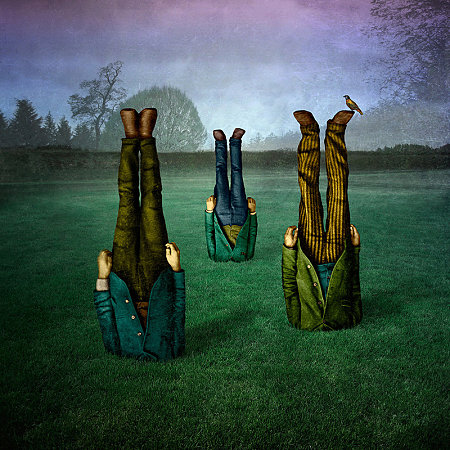
Global Positions
“Are we in South Carolina?” my wife asks.
Chris leans toward me and rests her hand on my thigh. She squints into the 4-inch by 4-inch screen of the GPS.
“Humm,” she says as she pats my leg and leans back in her seat.
It’s new, this GPS—map updates, accident notification, construction alerts—but I suspect Chris has no more faith in this unit than she had in the old one. I divide my attention between the highway and the back-lit map. It’s not really a map, though, as much as a lighted square fragmented by wriggling lengths of blue—threads lacing along an expanse of no man’s land. Not even land, really. Not even country, really. More like the white space surrounding a child’s drawing—father, mother, and child standing scrunched in one corner of the page. Along the central thread on the GPS screen lie symbols—crosses and shields and triangles. If I had read the GPS manual, I would know the meaning behind these symbols, but I tend not to read instruction manuals for computers. I watch my granddaughter with her latest digital devices. Press and play. Simple. My wife doesn’t read instruction manuals either. For her, it’s trial and error—or trial and triumph. Simple. Either way, I can’t say where we are.
*
Decades earlier, I had begun to read maps. My mother would often say I was obsessed with them, especially when I asked her to search through the stack my father had accumulated from service stations along the nation’s roadways—Pennsylvania or Ohio or New Jersey or New York. She would hand one back to me, and I’d unfold and hold it, even on short trips—25-minute jaunts to Nanny’s house, back-road treks to eastern Pennsylvania towns: Willow Grove, Millersville, Perkasie, Norristown. Often, my brother and I would tussle over the map, but it was large and covered nearly both our laps when fully open, so even when he won possession I could stare across his arm into the deeply creased folds of paper until he got bored and eventually surrendered all the terrain to me.
My father was typically restrained in his praise for his children, and it took me years to learn to listen for the undertone of encouragement beneath his few words. His was a secretive pride, and he was more likely to boast about his children’s accomplishments to strangers than to us. He rarely talked about my writing, but he kept copies of my early news stories on display in the shop where he cut men’s hair for a few bucks for nearly forty years. I imagine him peering past his barber chair, noticing the waiting customer flipping through the pages of the Bucks County Tribune, and nearly smiling as he trimmed away. Unwittingly, he taught me to watch and to listen carefully for his expressions of pride and indifference and the subtle tone that separated them. I sensed a modicum of encouragement toward my geographic curiosity as he glanced into the rearview mirror.
“Where are we?” he’d ask dryly.
“Coming up on Fairless Hills,” I’d announce as I searched the shoulder of the road for signs and markers. Then I’d return to the map, tracing my finger along the marked route: U.S. 1 or PA 413. Or coming up on Morgantown, past Blue Ball, past Leola—past the billboards for Zinn’s Diner, the quilt shop, the farm museum; past the front porch display of ladderback chairs. Or on longer trips—heading north to New York or veering west toward Ohio—I’d trace the interstates: I-95 or I-80 or I-76. Even frequently traveled and familiar routes didn’t discourage me from following along, my finger pressed against the representations of American roadways. I scanned the list of towns and cities in the accompanying index, enticed, even as a child, by regions to the west— Youngsville, Sheffield, Frenchtown—as if searching for my place in the world.
“Where are we?” my father would repeat, and I’d stare through the window for signs along the road—towns and cities and exits. I’d refer back to the map.
*
“Are we in South Carolina?” Chris asks.
Across the screen, threads of blues and reds wriggle along the eastern seaboard. Farther inland (at least as far as the screen reveals) the interstate intersects other threads, still more slender, winding through a field of white. Topography? An icon hides somewhere beneath digital layers of symbols for mountains and river valleys and campgrounds. But where? I have no idea. A legend? That, too, exists somewhere. One inch equals something, some number of miles, although knowing the scale seems unimportant. The manual is tucked into the glove box behind folded-up rental receipts, spare AC adapters, and tourist brochures lifted from scattered rest stops. I wonder now if I should have read the manual before we started out from Florida—from Sarasota to points north—but now it is too late.
